How to pull a casing pipe out of a well: rules for dismantling work
When the column that holds the well walls in an unchanged state ceases to perform its functions, the question inevitably arises of how to pull the pipe out of the well with the least amount of effort and money. Several methods are used in this matter. All of them involve the use of specialized equipment.
The article we presented describes in detail the practice-tested methods for removing casing from a water intake excavation. Problems that can be encountered when pulling a pipe string out of a shaft are given. Taking into account our recommendations, the problem will be solved with the least amount of effort and time.
The content of the article:
What are casing pipes?
A well is the same well, only very deep and of small diameter. To strengthen the walls and ensure the tightness of the well structure, casing pipes are used. If there are several layers of water in the soil that are unsuitable for consumption, then the casing will not allow them to mix with clean drinking water.
Pipes made of metal, plastic and asbestos cement are used as casing. The first of them are durable and resist mechanical loads well. They are produced with a diameter from 114 to 508 mm. They are equipped with threads, which facilitates both their installation and dismantling.
The main disadvantages are the tendency to corrosion and high cost.They are used mainly for deep mines with large water resources.
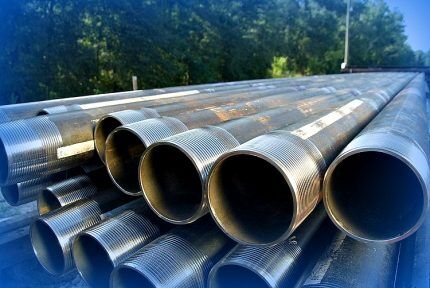
Plastic products do not have the disadvantages inherent in steel pipes. The internal diameter of PVC pipe is from 80 to 200 mm. The products also have threads, are chemically resistant, and lightweight. Plastic pipes are buried no more than 60 m.
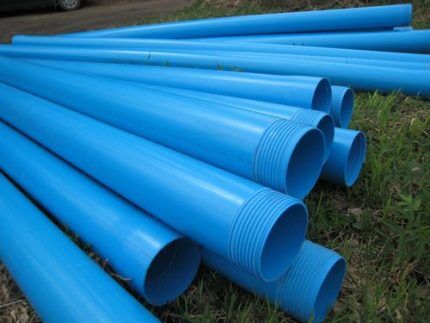
Asbestos-cement pipes have a diameter of 10–50 cm and a length of up to 500 cm. They are used less and less. They are fragile and unsafe for health.
When is casing removal necessary?
There are basically only three reasons for removing the casing from a well:
- The trunk has depressurized, which happens due to poor-quality connections of the casing string links or corrosion of the pipes by rust.
- A tool or equipment is hopelessly jammed in the barrel, making it impossible to remove the old pump and install a new one.
- A change in the design of the tube well is required: deepening, transformation well filter etc.
Other cases are not a reason to remove the structure. Sometimes you can save the situation by installing a polymer liner of a suitable diameter. If the break occurs at great depth, dismantling is simply impossible. Then it is easier to drill a new source than to spend a lot of money on restoring the old one.
What factors need to be taken into account?
Usually a well is being drilled on the site to great depths, so removing the casing pipe from it is not an easy task.
Before deciding on such an event, you need to clearly know the answers to the following 6 questions:
- what is the casing pipe made of?
- product weight;
- at what depth is its base located;
- how much time has passed since its foundation;
- under what conditions it was used;
- Is there a good enough reason why it needs to be dismantled?
It is possible that the dismantling work will turn out to be so complex, labor-intensive and financially expensive that it would be more rational not to solve the problem of how to get the pipe out of the well more easily and quickly, but to abandon this idea in favor of deciding to install a new water source.
List of related problems
In the process of removing the casing from the ground, you may encounter a number of unpleasant surprises. You must be prepared in advance for the fact that the prepared block and winch will not cope with the task due to insufficient traction force. Then you will have to order a crane, and this will add more problems: you need a visit, which will inevitably damage the landscape.
It should also be taken into account that the pipe may be so “tight” with soil that it will be necessary to reduce the coefficient of friction by drilling holes around the head and pouring a large amount of water into them. The pipe will come out of the wet ground much easier. A side effect of such actions is the likelihood of the mine walls collapsing.

Insufficient rigidity of the extracted pipe. If it is made of asbestos cement, then removing it without damage is out of the question.
It will simply fall apart and come to the surface in the form of separate fragments, and the fragments will end up at the bottom of the well. It is better not to reuse such a shaft if an asbestos pipe has been removed from it, given that this material is far from safe.
Preparing to dismantle the wellbore
Knowing about possible difficulties, you should prepare for the process thoroughly.
The first step is to determine the weight of the product, for which:
- measure the well depth, pipe diameter, wall thickness;
- open the directory and, focusing on the diameter and wall thickness, find the weight of 1 linear meter. m;
- multiply the found value by the depth of the shaft and obtain the required mass of the pipe.
This value will be the basis when choosing a winch based on traction force.If the figure turns out to be significant and there is no winch with such a traction force, then the only option is to order a crane. When deviations from the calculated value are insignificant, a conventional winch will do.
Methods for removing pipes from a well
Professionals have their own methods for pulling out casing pipes: stretching followed by breaking, flushing with walking, twisting.
Tension method for column extraction
To use this method you will need a traveling system or a jack. The force generated during tension is above the critical plasticity limit of the material casing pipe. Therefore, the structure may not withstand and burst.
The process algorithm is as follows:
- A trench about 1 m deep is dug around the mouth of the pipe.
- A clamp is put on the pipe, and cables are attached to it, after which the structure is slightly tensioned.
- The clamp to which the cable is attached is moved lower and the same actions are repeated. This ensures smooth pulling.
- The upper edge of the casing structure is pulled out until a break appears. The fragment is removed from the shaft, and the remaining part is captured with a special fishing tool and the process is continued, or after replacing the damaged part of the shaft, the casing is installed in its original place.
It is advisable to use this option for dismantling pipes with a large diameter and thick walls.
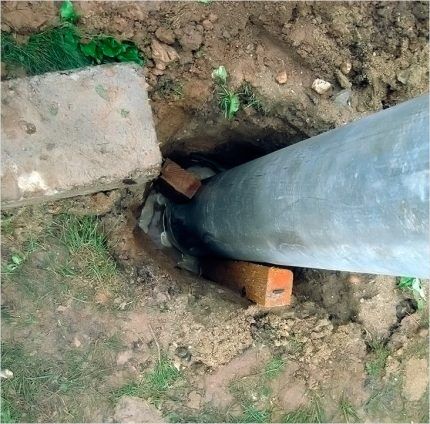
If the well axis has a vertical deviation, this extraction method cannot be used. For such complex work, it is better to hire a drilling crew.
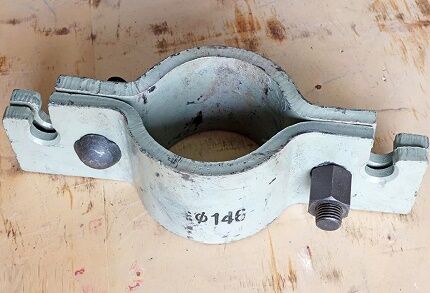
The hoist used for lifting must have a large load capacity. The best option is to use jacks. You should know that you cannot count on further use of the removed pipe.
Removal by washing
If the casing pipe does not come out of the ground due to the formation of a sand plug, a relatively simple method is used to remove it - washing and stretching. To do this, you need a pump with a special flushing device. The pressure part of the pump is connected to the top of the pipe.
The pressure should be minimal, but sufficient for water circulation. The column is washed, and after the sand flows out, the pressure is increased. The body of the pipe is walked around, turning it with the help of a rotor and loosening it. All this is done in parallel with washing. Thus, the coefficient of friction is reduced, and the string will come out of the well more easily.
The ideal option is when the diameter of the pipe allows not only to fix the pump in the upper part, but also to lower the second one to the base of the column. The reverse supply of water is started as soon as the edge of the flushing hose drops 300 cm below the shoe-coupler of the sedimentary column. The process is continued until the sand blockage near the pipe is completely eliminated.
Sometimes when the pipe is lifted up to 10 m, it becomes impossible to remove it due to the strong compaction of the plug. In this case, there is only one way out - to remove individual fragments. Separately, we should dwell on the process of removing the pipe.
First, a piece of reinforcement with a diameter of about 18 mm is welded onto her body. This element is needed to secure the winch slings and begin lifting the casing riser.
To lift, it is necessary to apply a vertically directed draft force. To do this, a block is installed at the highest point of the pipe being removed, and a cable is thrown through it. When the winch drum rotates, torque is converted into traction force.
A light weight pipe can be lifted using a lever. Its end is brought under the welded reinforcement and, applying force, the riser is gradually pulled out of the ground.
Application of the unwinding method
Using this method allows you to unscrew the casing elements and remove them from the well.
To apply the method, you need a supply of tools:
- fishing bit;
- rotor;
- perforator;
- cumulative torpedoes.
A special fishing bit with a left-hand thread and a steel drill pipe are lowered into the shaft. The rotor turns the pipes counterclockwise.
Having completed approximately 20 revolutions, the casing string is walked, increasing the load to the maximum. If the fished pipe does not break, the pacing and unwinding is repeated. The result of these efforts should be incomplete unscrewing of the connections.

If the thread cannot be loosened even after a number of cycles, a special tool is used, rotating which causes the pipes to vibrate due to friction and transmission of torque to the removed riser.
Result: After rotating the tool for 1 hour, the connection becomes loose. At the next stage, grab the upper rim of the column and unscrew its fragment. To remove the unscrewed part of the pipe outward, a tensile force is applied.The steps are repeated until the entire column is dismantled and all its elements are at the top.

When all efforts do not lead to success, a radical method is used - violating the integrity of the structure by using cumulative torpedoes. As a result of their explosion at a given depth, ring cuts appear on the body of the pipes. All that remains is to cut off the individual elements using a hammer drill or other cutting tool.
All this work can be done by specialized organizations. Their cost is considerable, so the owners of country houses are looking for other ways to remove the pipe themselves.
Factory and homemade equipment
To remove casing from a deep well, professionals use factory-made equipment.
It is characterized by such nominal parameters as pressure in MPa, stroke force - forward and reverse in force, maximum torque in kN/m, maximum clamping or extraction force in force, angle of rotation of the clamps, weight in kg, dimensions in mm, range of diameters of the pulled out pipes
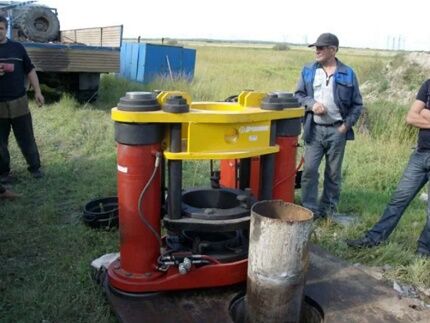
The hydraulic return cylinder rods are combined with supports equipped with a crossbar on which the top plate rests. To clamp the support column, this plate has a special movable gripper.Both fixed and movable grips are 3-wedge jaws, internally threaded and placed in a cage.
Hydraulic cylinders are connected to the pumping station. In the event of an emergency situation when there is not enough force to remove the pipe, use a clamp wedging device. The tension may not be enough if, due to unforeseen circumstances, additional friction forces appear between the pipe body and the walls of the well.
The equipment is installed on the casing stand and the latter is clamped using a movable gripper, and then lifted. The lift is equal to the stroke of the pistons. The next step is to fix the pipe with a fixed grip and return the top plate to its original position. The pipe is removed by repeating these steps. While the riser is being drawn out, it is supported by a crane.
With the help of such equipment, casing pipes are pulled out of the ground, the top of which is almost invisible, since the installation has a low pick-up. Another advantage of the mechanism is the ability to lift steel pipes, the standard sizes of which are in a wide range.
To dismantle small-diameter pipes on your site, you can make suitable equipment yourself. For this you will need 2 channels for the racks, a drum for the cable, a bearing with an internal diameter of 40 mm, a cable, and a handle.
Two supports are made, about 1 m high and approximately 0.6 m wide. They are shaped like the letter T when tilted. A bearing is attached to the uprights at the top, and an axle is passed through it. The drum and handle are attached to the axis.
The cable is wrapped around the pipe and the drum begins to rotate. The pipe gradually emerges from the ground. If a plastic product is to be dismantled, a special clamp is used.
As the pipe is removed, the cable is lowered lower. When the structure has a significant length, a special device is used - a jig - to hold the column while moving the cable to a new position.
Conclusions and useful video on the topic
Video #1. The author of the video filmed the process of removing the PVC casing pipe:
Video #2. Tools and equipment for pulling casing:
Depending on financial capabilities and the availability of equipment, you can use any method to remove the pipe. It is important to be careful and not neglect safety precautions. Perhaps, after all the calculations, you decide that it is better to lay a new well.
If you had to pull casing from a wellbore, tell us how you managed to remove it. Share information that site visitors can use in similar situations. Please write comments, ask questions, leave posts with your own opinion about the material we offer and photos on the topic.




I haven't encountered such a problem yet. But my neighbor’s broken pump got stuck, and I helped him pull it out. They installed a tripod with which they drilled the well, and attached a fairly powerful chain winch to the top. And almost exactly as it is said here, they dug up and grabbed the pipe using a clamp, doused it with a large amount of water and slowly pulled it out, but periodically added water as it seeped out and tapped it with a wooden mallet. The first meter was very slow, but then it went like clockwork.
Hello, recently I also had problems with casing pipes. They couldn’t get it out; once they almost broke the entire system.The pipes were of rather dubious quality, or maybe time had an effect, then it didn’t matter. The removal methods above helped. There were no particular difficulties during the execution; everything was done quickly. Then we ordered better quality pipes, so far no problems have occurred.
They also pulled out the casing pipes, at first they decided to try it themselves, but nothing came of it, the pipe was tightly covered with soil, it did not want to come out. We had to involve drillers, they did everything quickly: they hooked the casing with a clamp and pulled it out with hydraulics, they did everything carefully. New ones were immediately installed in the wellbore; we bought them in advance. So, in my opinion, it is better to immediately contact professionals.